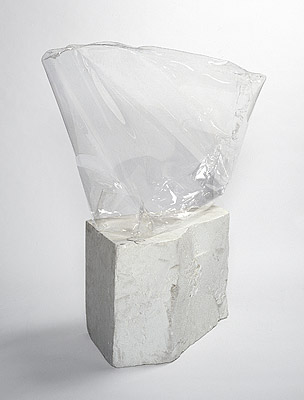Mikala
DWYER
Australia
1959
Sculpture
2002
polystyrene and heat shrunk plastic
155.0 (h)
x 110.0 (w)
x 80.0 (d)
cm
Gift of Peter Fay 2005
National Gallery of Australia, Canberra
NGA 2005.840
© Mikala Dwyer, Licensed by VISCOPY, Australia
Sculpture presents a translucent heat-shrunk plastic form atop a polystyrene base. In this apparently simple construction, Mikala Dwyer examines the relationship between object and plinth. Grounded, at least notionally, to its site of display, the apparent weightlessness of the plastic entity suggests the work may take flight with even the slightest gust of wind.
Dwyer’s work explores ideas of speculation and chance. She comments that ‘uncertainty is always a component of my work … I use the generative possibilities of accidents and mistakes.’[1] The artist’s preoccupation with fortuitous physical forms results in works that question the nature of contemporary sculptural practice. Using plastic, and manipulating the effects of temperature on this substance, Dwyer renders some of her creative decisions in Sculpture over to chance.
The plinth of Sculpture is an integral component of the work. Like past artists such as Marcel Duchamp and Constantin Brancussi, Dwyer has carefully structured the overall effect. The polystyrene base resembles white marble―the traditional material for 18th- and 19th-century pedestals. Dwyer appropriates the technique of direct carving, replicating chisel marks, line markings and the uneven surface finish of work in progress.
Much like the frame of a painting, the plinth denotes a boundary between the quotidian or everyday, and another space which is profoundly visual. Serving a dual function, the plinth at once protects and elevates a work of art, proclaiming the importance of an object. This space becomes the locale where artists flaunt their technical virtuosity and artistic capabilities. The very fact that Dwyer’s plinth is constructed from a lightweight commercial material negates modernist ideals of display and reception, and belies the artist’s resistance to traditional methods of sculptural presentation adopted by museums and galleries throughout the ages.
Lisa McDonald
International Art
National Gallery of Australia, Canberra
[1] Linda Michaels, Mikala Dwyer, Museum of Contemporary Art, Sydney, 2000, p 7

